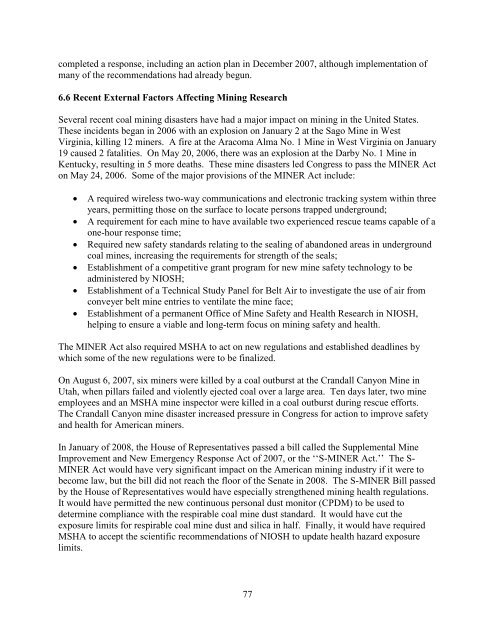One Hundred Years of Federal Mining Safety and Health Research
One Hundred Years of Federal Mining Safety and Health Research
One Hundred Years of Federal Mining Safety and Health Research
- No tags were found...
Create successful ePaper yourself
Turn your PDF publications into a flip-book with our unique Google optimized e-Paper software.
completed a response, including an action plan in December 2007, although implementation <strong>of</strong><br />
many <strong>of</strong> the recommendations had already begun.<br />
6.6 Recent External Factors Affecting <strong>Mining</strong> <strong>Research</strong><br />
Several recent coal mining disasters have had a major impact on mining in the United States.<br />
These incidents began in 2006 with an explosion on January 2 at the Sago Mine in West<br />
Virginia, killing 12 miners. A fire at the Aracoma Alma No. 1 Mine in West Virginia on January<br />
19 caused 2 fatalities. On May 20, 2006, there was an explosion at the Darby No. 1 Mine in<br />
Kentucky, resulting in 5 more deaths. These mine disasters led Congress to pass the MINER Act<br />
on May 24, 2006. Some <strong>of</strong> the major provisions <strong>of</strong> the MINER Act include:<br />
• A required wireless two-way communications <strong>and</strong> electronic tracking system within three<br />
years, permitting those on the surface to locate persons trapped underground;<br />
• A requirement for each mine to have available two experienced rescue teams capable <strong>of</strong> a<br />
one-hour response time;<br />
• Required new safety st<strong>and</strong>ards relating to the sealing <strong>of</strong> ab<strong>and</strong>oned areas in underground<br />
coal mines, increasing the requirements for strength <strong>of</strong> the seals;<br />
• Establishment <strong>of</strong> a competitive grant program for new mine safety technology to be<br />
administered by NIOSH;<br />
• Establishment <strong>of</strong> a Technical Study Panel for Belt Air to investigate the use <strong>of</strong> air from<br />
conveyer belt mine entries to ventilate the mine face;<br />
• Establishment <strong>of</strong> a permanent Office <strong>of</strong> Mine <strong>Safety</strong> <strong>and</strong> <strong>Health</strong> <strong>Research</strong> in NIOSH,<br />
helping to ensure a viable <strong>and</strong> long-term focus on mining safety <strong>and</strong> health.<br />
The MINER Act also required MSHA to act on new regulations <strong>and</strong> established deadlines by<br />
which some <strong>of</strong> the new regulations were to be finalized.<br />
On August 6, 2007, six miners were killed by a coal outburst at the Cr<strong>and</strong>all Canyon Mine in<br />
Utah, when pillars failed <strong>and</strong> violently ejected coal over a large area. Ten days later, two mine<br />
employees <strong>and</strong> an MSHA mine inspector were killed in a coal outburst during rescue efforts.<br />
The Cr<strong>and</strong>all Canyon mine disaster increased pressure in Congress for action to improve safety<br />
<strong>and</strong> health for American miners.<br />
In January <strong>of</strong> 2008, the House <strong>of</strong> Representatives passed a bill called the Supplemental Mine<br />
Improvement <strong>and</strong> New Emergency Response Act <strong>of</strong> 2007, or the ‘‘S-MINER Act.’’ The S-<br />
MINER Act would have very significant impact on the American mining industry if it were to<br />
become law, but the bill did not reach the floor <strong>of</strong> the Senate in 2008. The S-MINER Bill passed<br />
by the House <strong>of</strong> Representatives would have especially strengthened mining health regulations.<br />
It would have permitted the new continuous personal dust monitor (CPDM) to be used to<br />
determine compliance with the respirable coal mine dust st<strong>and</strong>ard. It would have cut the<br />
exposure limits for respirable coal mine dust <strong>and</strong> silica in half. Finally, it would have required<br />
MSHA to accept the scientific recommendations <strong>of</strong> NIOSH to update health hazard exposure<br />
limits.<br />
77
















